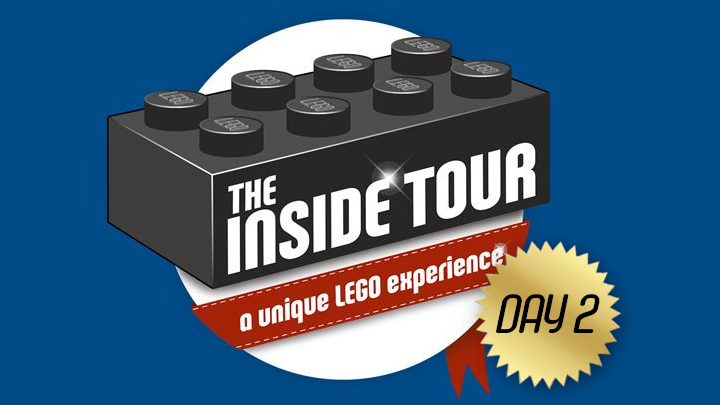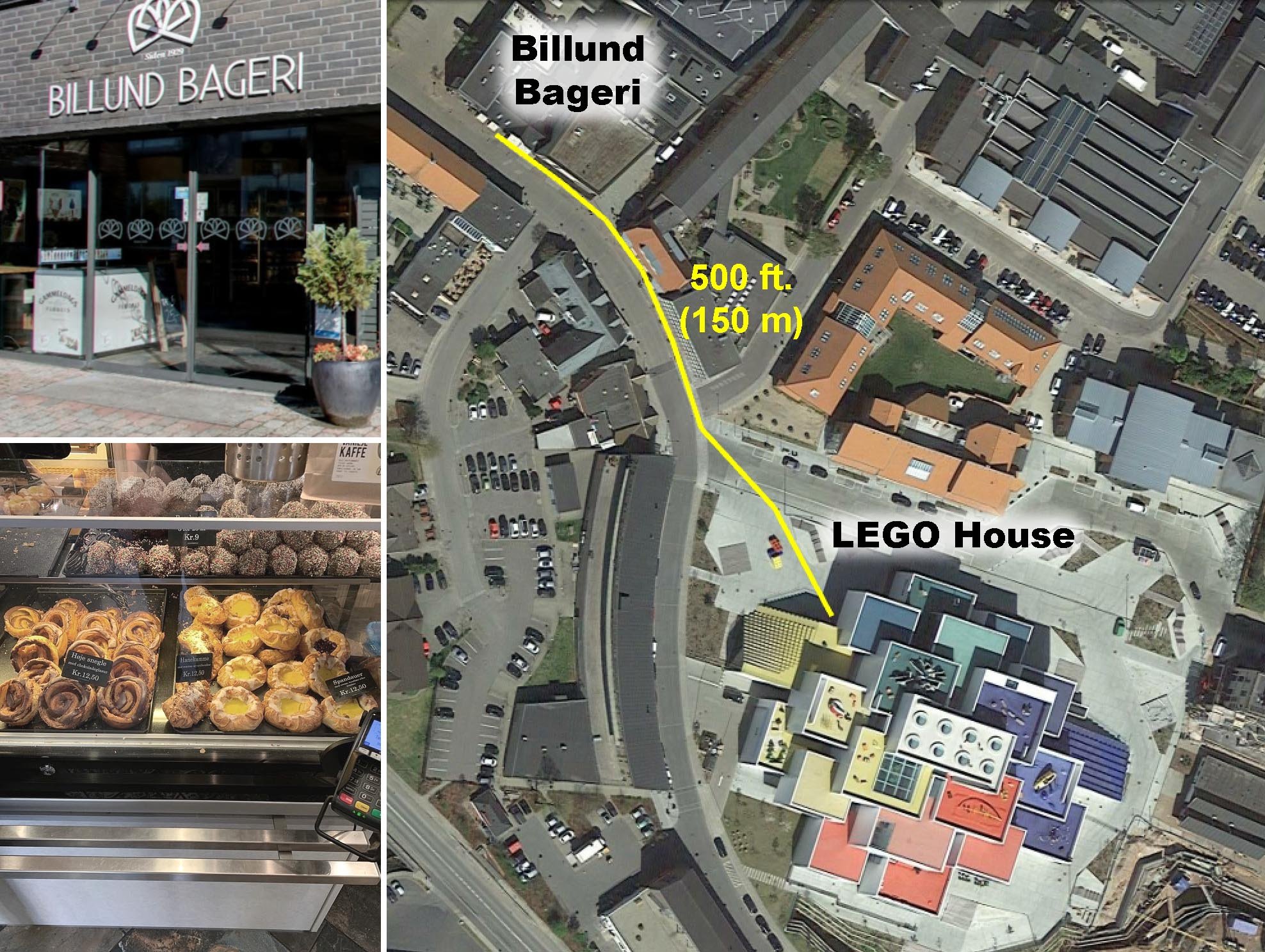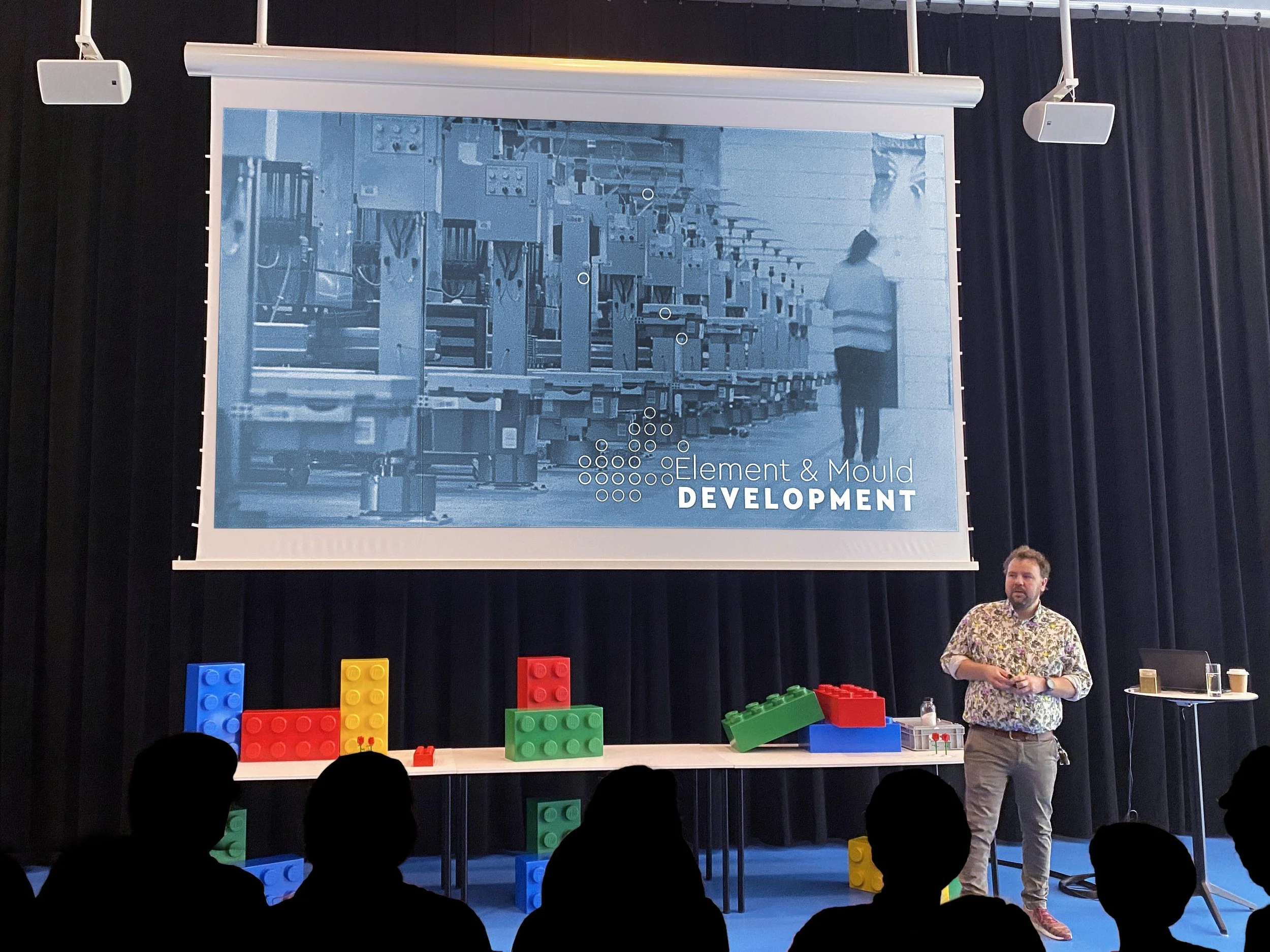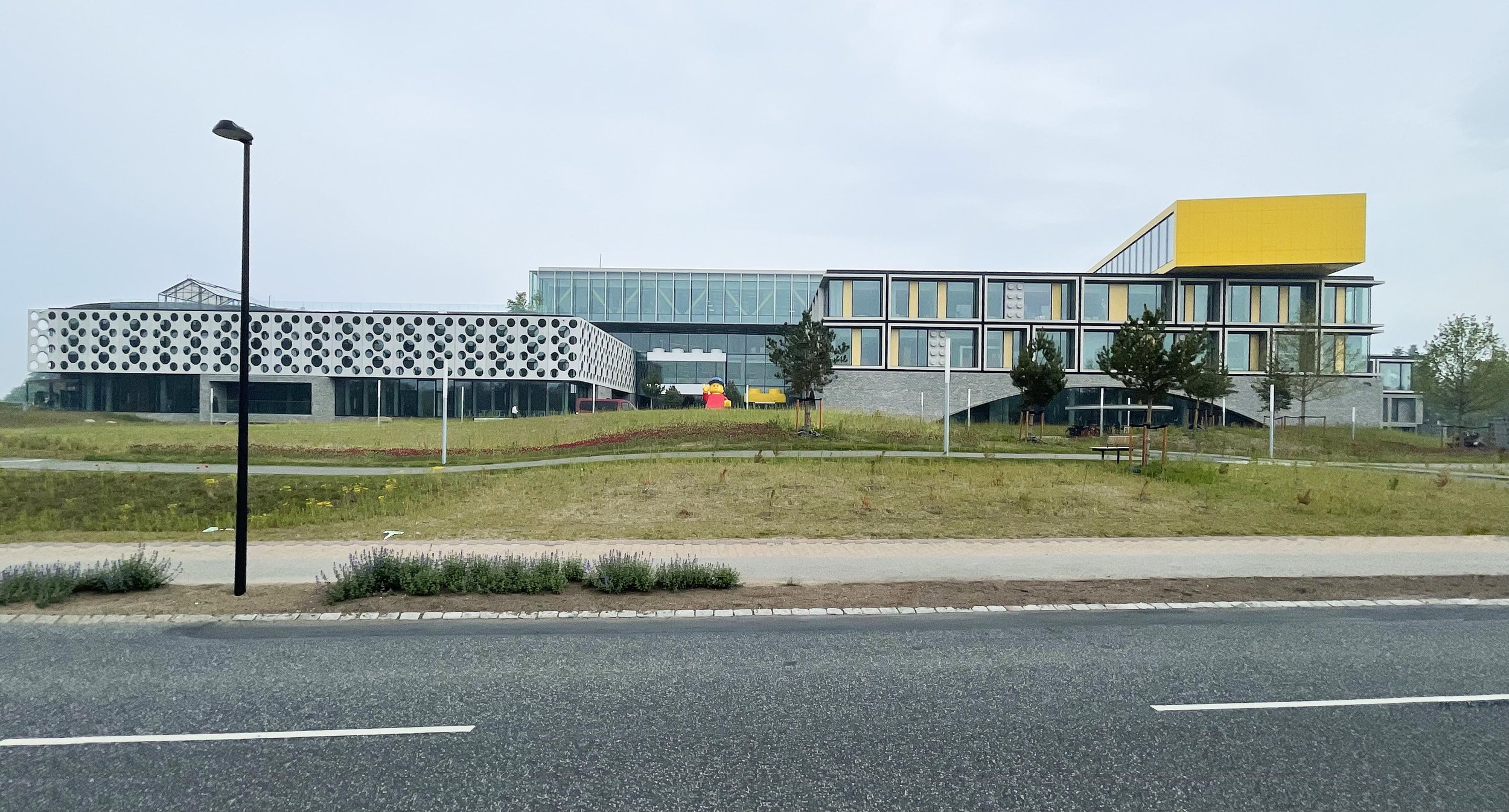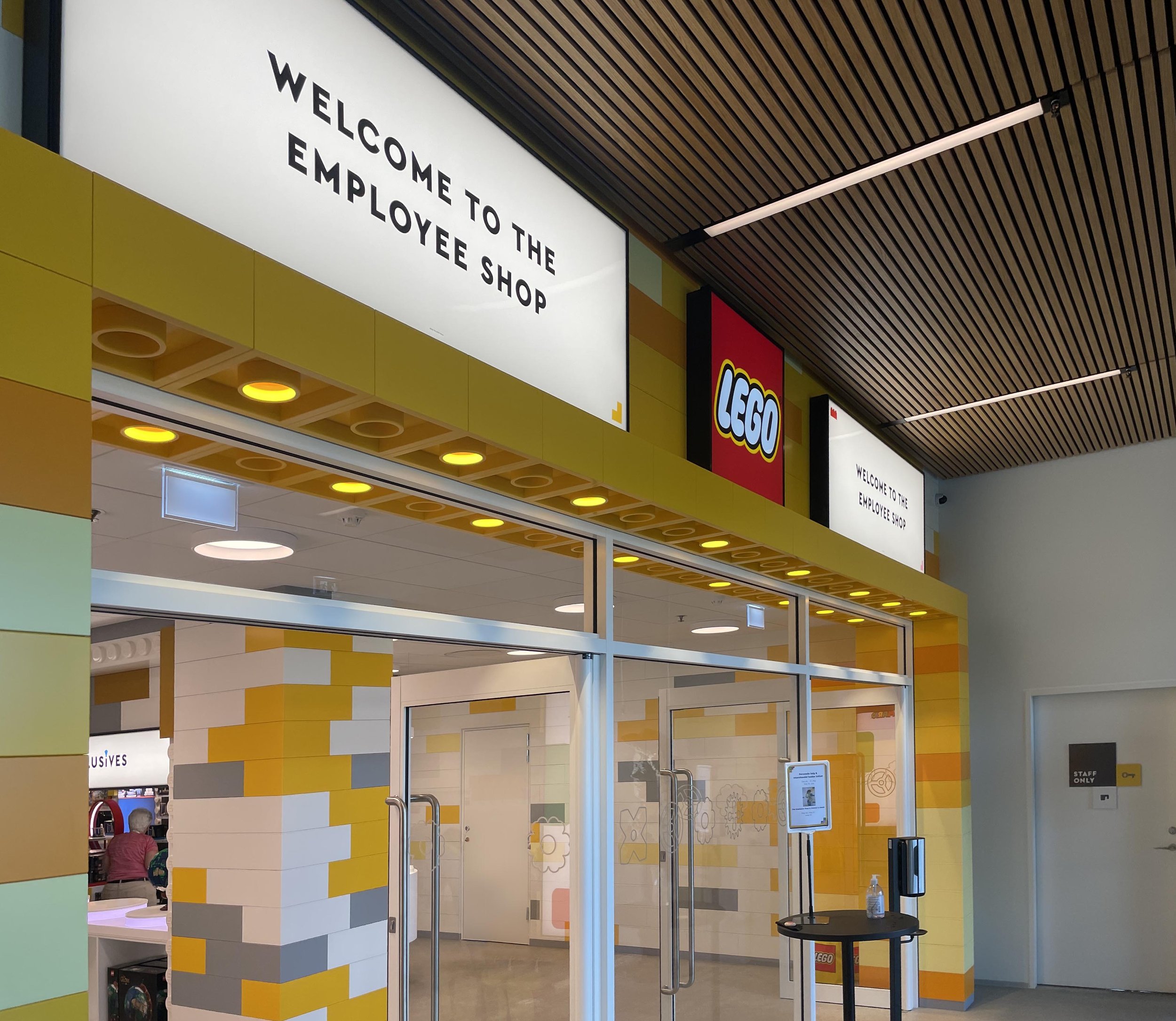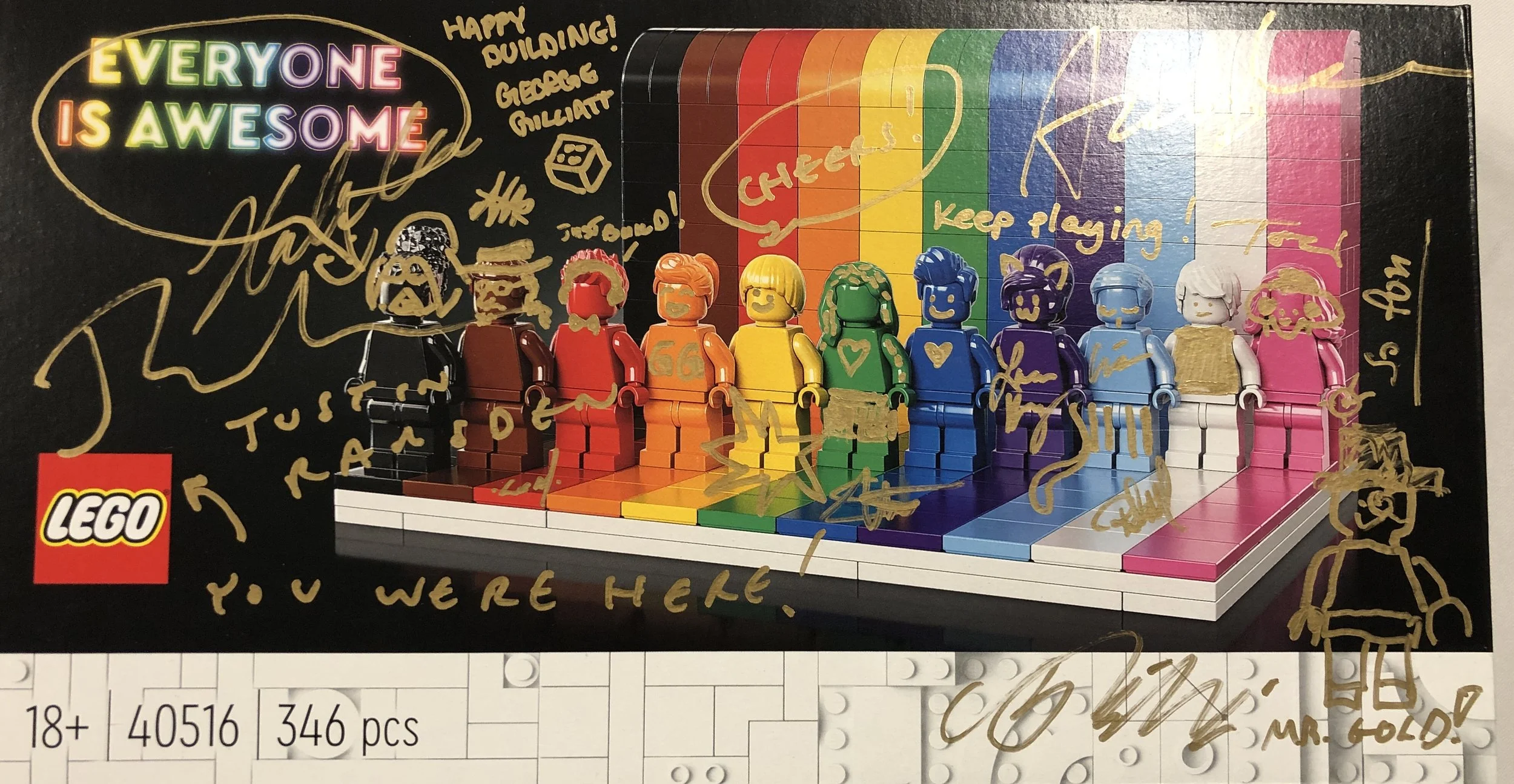Inside the LEGO Inside Tour 2022: Day 2
/Last month, we shared Wayne Tyler’s first-day experience attending the LEGO Inside Tour (which we highly recommend you read first). Today we bring you the second chapter in that installment. The guided tour is a “once-in-a-lifetime experience” for the biggest LEGO fans that includes a factory tour, chats with designers, special access through normally restricted areas, and lots of amazing swag.
Beginning Day 2
We had been in Denmark for a week prior to the start of the LEGO Inside Tour (LIT). In that time, we discovered and had gotten to used to having Danish pastries for breakfast. Back in our hotel room after a long Day 1, it was decided that we should start Day 2 with pastries, so we went online to find some local bakeries in Billund. Much to our delight, we found a bakery just down the street from LEGO House. So, Day 2 started with sweet rolls and tea at the Billund Bageri.
Exterior of the store where we got breakfast, a sample of their baked goods and how to get there from LEGO House. Satellite photo courtesy of Google Earth
After a leisurely and delicious breakfast, we headed back to the LEGO Forum room at the LEGO House for the beginning of the second day’s adventures. From what we had heard before, these activities would include a tour of the Kornmarken production facility to see the process of brick creation from raw plastic to boxed crates ready for worldwide shipping, the infamous shopping trip to the LEGO employee’s store, and an evening with the designers who had reviewed our builds from the previous day.
Schedule for Day 2 of the LEGO Inside Tour 2022. Photos courtesy of Arlett Michael and Michael Kűhberger.
Starting the day was a presentation from Søren Jensen, Head of Prototype and Mould Engineering. A 10-year employee at LEGO, Søren prefaced his presentation by showing us his mobile phone, placing it on a nearby table, and saying, “If the phone rings, I’m probably going to need to leave. My wife is expecting to have our baby sometime in the next three days.” There was a slight murmur from the LIT participants which ranged from, “Congratulations!” to “Oh, I hope it doesn’t happen during his talk...”
Before the presentation given by Søren Jensen. Photo courtesy of Arlett Michael and Michael Kűhberger.
Søren’s presentation covered both the history of plastic molding used by LEGO and a technical—but very interesting and understandable—explanation of the molding process as it is currently implemented. Unfortunately, as with several other aspects of the Inside Tour, we were not allowed to record the talk or take any pictures.
During the presentation, Søren passed around a test mold, a couple of plastic bricks made by the mold, and an example of the mixed raw materials used to make red bricks. It is surprising how little coloring is needed to get the deep red bricks we’re so used to seeing. He gave proportions of the color component to base components, which I don’t remember exactly, but it’s something like 2% color and 98% uncolored base.
Also, when passing around the test mold and bricks from that mold, he warned us not to put one of the bricks back into the mold. Tolerances are so tight that it would be difficult to get the brick out of the mold. And what happened? You guessed it—someone put a brick in. Luckily, Søren had a tool he could use to pop the brick back out.
The LEGO Factory
Søren’s talk was in preparation for the next event on the tour, going to the LEGO factory at Kornmarken on the outskirts of Billund. Only a 10-minute bus ride from LEGO House, the factory is one of only a few locations worldwide where LEGO parts are produced.
Before leaving for the bus, we were given a safety presentation for the factory by Peter Anker. First thing to check: no open-toed shoes. Everyone had the proper footwear. Then came admonitions about following the tour guide’s instructions and staying together as a group. Arriving at the factory, as we got off the bus, again we had to hand over our cameras, phones and other recording devices.
Walking to the entrance to the factory, there was a sprinkle of rain. This was the only bad weather we encountered on our Inside Tour. Actually, it was the only bad weather we had during our seven days in Denmark. Several of the LIT staff and designers commented on how unusually warm the temperatures had been and that we were lucky to have had such good weather.
Entrance to the Kornmarken LEGO factory. Photo courtesy of Alex Kulvelis.
After crowding into the lobby area of the factory, we were split into two groups and introduced to our guides. Our group was led by Tine Vind. She was as excited as Stuart Harris had been on the first day to be leading an Inside Tour group through the factory for the first time in two years.
Prior to entering the factory, we all had to don yellow safety vests and a headphone/receiver system so that Tine could talk to us over the noise inside the factory. While checking that everyone could hear her, she gave a little background on the factory.
Approximately 600 boxes (with 12 kg LEGO per box) are made every hour.
The Kornmarken factory produces 1,300 bricks per second.
The greatest number of parts created by a single mold at one time is 168.
The mold factory of the 1970s was located where the new LEGO Campus was built.
The factory runs 24/7, 331 days per year with three shifts on weekdays and two shifts each day on the weekends.
As we walked the factory floor from one end to the other, we got to see the different types of raw materials used, a wide variety of colorings, and the molding machines in action. They were producing everything from 1x4 plates to multicolor wings with an amazing conveyor system shuttling LEGO pieces from the mold machines to the storage warehouse.
Part of that conveyor system are the AGV (Automated Guided Vehicles). They retrieve bins full of LEGO parts from the molding machines and replace them with empty bins. They take the full bins to another automated system which places lids on them, and then off they go to the warehouse. The AGVs are fully independent, guided around the factory by magnets embedded in the floor, and equipped with laser scanners to detect obstacles. (Why am I going on and on about the AGV? Well, spoiler alert... it was the exclusive set given to the Inside Tour participants the next day!)
Interestingly, while walking the factory floor, AGV #17—as pictured on the front of the exclusive set—tried to run us over… twice. We weren’t sure it even slowed down as it approached our group. It felt a little like being stalked by a Skynet H-K from the world of “Terminator”.
Swag from the Billund Kornmarken factory tour.
At the end of the factory tour, we all gathered back in the lobby and were handed two bits of swag: a brick labeled “Moulding Billund” on one side and “I was here” on the other, and a LEGO chest full of red color pellets.
While we couldn’t take any pictures during the tour, you can get a good feeling of what it was like being on the factory floor by watching the video below.
LEGO Campus
From there we took the bus to the new LEGO Campus where we gathered to hear two presentations. The first, given by Anne Frausing, introduced us to the new headquarters. For employees of LEGO, it is an amazing facility that you can read all about thanks to Are’s article. The second presentation was about the AFOL community given by Jan Beyer, AFOL Community Integration Manager for the LEGO Group.
LEGO Campus. Photo courtesy of Rob Starkman.
We had two takeaways from these presentations. The first one about LEGO Campus would have been more interesting had it included an actual tour of the Campus. However, we had just come off of wandering the Kornmarken factory for an hour and a half, so sitting down DID feel good. And second, it would have been better if Jan had more time allotted for his presentation since it was so interesting. But again, we understand the reasoning for keeping it short… it was lunchtime and we were hungry. We received yet another bonus at the end of the two presentations, a four- or five-pound box of assorted loose LEGO pieces.
Then it was time for lunch at the newly opened restaurant, called 1932, in the Campus. It is a 4-star restaurant in a stunningly appointed space run by a master chef (though I’m not sure that’s his correct title, and unfortunately, I didn’t get his name). The restaurant looks out on an open garden area where produce is grown for use in the fare offered to guests.
Lunch at the 1932 restaurant. Photo courtesy Jordi and Siege.
I am not a foodie so I don’t remember the details of the meal, however the one thing I do remember is the white asparagus in the salad was the first harvest from the garden just outside the restaurant windows.
After lunch was the event we had all been waiting for—shopping in the employee’s store…with the employee discount. And yet again, we were not allowed to take photos while inside the store but this is what it looks like from the outside.
Front of the LEGO employee store. Photo courtesy Rob Starkman.
I have two observations about shopping at the employee store. First, with the employee discount and the exchange rate at the time, we made out like bandits! Even better that they ship some of it home for you.
This was the total collection of sets obtained during our time in Billund…
Second, just like any other LEGO store worldwide, there were some sets that were out of stock. That was unfortunate because we were looking to pick up the Titanic. We got a few other sets instead.
After the action-packed morning at the factory, an incredible lunch at 1932, and the purchasing frenzy in the afternoon, we were given a couple of hours off to do our own thing. We took the 15-minute walk back to our hotel room to relax and rejuvenate for the evening’s activities.
In the cloudy late afternoon light, the entire group (LIT participants, LEGO designers, and the LIT crew) gathered in LEGOLAND just outside the hotel entrance to the park. We had another quick chance to talk with some of the designers before we all ambled off to eat dinner at the saloon restaurant in LEGOREDO Town, LEGO-shaped fries included.
Like the previous meal with the designers, they mixed with LIT participants at various tables in the restaurant. Sitting at our table were Lauren Cullen King (graphic artist) and Carsten Lind (element designer) who had been part of the designer presentations on Day 1. With 35 LIT participants, 13 designers, and 5 LIT staff, the restaurant was extremely noisy, so conversing over the table wasn’t the easiest. Yet, we had a hilarious conversation about the difficulty in learning Danish, Lauren coming from the US and Carsten being from the area. Also getting to talk with Lauren in-depth about the ins and outs of graphic art within a LEGO design team was fascinating.
Trophies and Trivia
After dinner, we all went back to the LEGOLAND Hotel to settle in a conference room for the LIT Model Review.
LEGO designers: Mike Psiaki (left), Carl Merriam (middle), Niels Milan Pedersen (middle right), Nancy Tsai (far right). Photo courtesy Rob Starkman.
The group of designers had looked at our builds from Day 1 and were going to award trophies for the best in five different categories. They had split into five groups of two or three designers each and judged the builds in the following categories:
The Biggest Stud Award for Best Use of LEGO DNA
The Old Gray Spade Award for Best Parts Usage
The Tommy Gun Thompson Award for Best Function
The Legends of Mata Nui Award for Best Story Telling
The Mike Psiaki and Carl Thomas Memorial 21039 Saturn V Award for Best Overall Design
For each award, the group of designers would explain the judging criteria and then name three models they had selected for consideration. That was followed by an explanation for why the winner was selected, and then they revealed the winner.
Trophies to be given to awardees. Photo courtesy of Alex Kulveli.
Also in attendance was Justin Ramsden, a Senior Designer at LEGO, known for his work on Hogwarts, Monkie Kid, “The LEGO Batman Movie” and “The LEGO Movie 2”. He provided commentary and levity throughout the evening and was a great bonus to our gathering.
LEGO designers: Justin Ramsden (left), George Gilliatt (right) and Lauren Cullen King (top right). Photo courtesy of Arlett Michael and Michael Kűhberger
This first trophy, for The Biggest Stud Award for Best Use of LEGO DNA, was awarded to “Thank you Ole Kirk”, a BrickHeadz-style model of LEGO founder Ole Kirk Christiansen along with representations of the six core values of The LEGO Group.
“Thank you Ole Kirk” with award trophy. Photo courtesy Rob Starkman.
The Old Gray Spade Award for Best Parts Usage went to “A Rat Eating Snake”, built by the youngest member of the Inside Tour (no, not the 3-month-old baby) with a little help from Niels Milan Pedersen, who built the rat and the cheese.
“Rat Eating Snake”. Photo courtesy Rob Starkman.
The Tommy Gun Thompson Award for Best Function went to “Street Flyer Ace”. As the designers were explaining why this build was chosen, Mike Psiaki stopped them and mentioned to the room that in looking closely at this MOC, they noticed a piece was used that wasn’t from the design room parts inventory we had used for our models on Day 1. As a matter of fact, the part stopped being produced more than a decade earlier in 2008! So he asked the LIT builder just exactly where they got this part.
“Street Flying Ace”. Photo courtesy of Alex Kulveli.
It turns out that when the LIT crew allowed us the opportunity to grab some parts and continue building our models after the Day 1 session finished, some folks took their MOCs back to the hotel and worked on them a bit more. Well, each room in the hotel also has a drawer full of LEGO for guests to play with while staying there, so the builder of the “Street Flyer Ace, needing a specific part, rummaged through the drawer until he found one.
The designers were both impressed with the model and his ingenuity for finding a useable part without accessing the parts inventory—though there was an entertaining lingering question of… “was that legal?”
The fourth award, The Legends of Mata Nui Award for Best Story Telling, went to “Protecting the Treasure”.
“Protecting the Treasure”.
Before the last award was given out, there was a break for a game called “Name That Brick(!!)” with three lucky LIT participants trying to guess the official LEGO name for a variety of parts. The contestants were shown a picture of a piece and were asked to name it. If you think that the naming conventions used by BrickLink or Rebrickable don’t make sense, the official LEGO names are SO far beyond those.
Image via BrickLink.
Rather than give all the answers away in case they are reused in future Inside Tours, here is just one that had us all wondering who names these pieces and how do they come up with the name!? Say hello to the “Thill for Gig” aka the horse hitching element.
Each of the three contestants was asked before the game began why they thought they would win. One of the three was the young LIT participant who built “Rat Eating Snake”. His answer was, “I think I will win because… I’m a kid!” which elicited a roar of laughter and approval from the room. That must have been the edge he had over the other two because he did, in fact, win.
That left the last award to be given was The Mike Psiaki and Carl Thomas Memorial 21039 Saturn V Award for Best Overall Design. The winner was “Sewing Machine.” The description read, “Sewing machine with quilt. Inspired by the wooded LEGO sewing machine in the LEGO Idea House.” Though simple in appearance, what made this MOC unique was that it actually worked. As the hand wheel is rotated, the needle and needle bar moved up and down vertically. It was elegant, efficient, and well-designed… definitely the best of the models.
“Sewing Machine”. Photo courtesy of Rob Starkman.
MOCs and Memories
These were our models. Though not in the final three in any of the five categories, they were both fun to build as we were pushing our personal envelopes.
“Christmas Heart” and “Flash and Thunder”.
My wife is a novice in the LEGO world. Building anything that holds together is an accomplishment. She loves Christmas heart ornaments, so when she discovered the large red curved pieces in the designer’s parts inventory, she immediately thought of hearts. Her design is based on a Danish woven basket heart. As she was building it, she encountered her nemesis: it wasn’t staying together. I wandered off to get more parts for my model and when I look up, there is Henrik Andersen… yes, THAT Henrik Andersen, lead designer on many, many LEGO Star Wars sets including the massive UCS AT-AT and UCS Imperial Star Destroyer, working with her to make the heart ornament more stable. It seemed so incongruous in my head but confirmed the deep talent of the designers working with us to tackle any design idea.
My model was my first attempt at making an organic form of a runner. I’ve been designing and building MOCs for five years, but everything—and I mean everything I ever worked on—has been architectural and mostly geometric. So, this type of thinking and designing was a reach. After getting the form of the runner, I spent quite a bit of time trying to figure out how to attach the red speed lines. After George Gilliatt wandered over and asked if he could help. I explained my problem and some of the approaches I tried that didn’t work. He immediately said, “Well, you could use angled Technic connectors to approximate the curvature of the back and plug Technic axles into them for the speed lines.” In an instant, my problem was solved! The other thing about LEGO designers I noticed is that through experience and shared knowledge, they know more ways of solving a build problem than I will ever know. I sure wish I could tap into that pool of knowledge every time I get stuck when building!
And then it was done! Another long day filled with experiences of so many different aspects of LEGO—from the making of bricks to purchasing them. From being chased by automated machinery to having our models critiqued by designers as if we were peers, not just AFOLs. It was an incredible Day 2 that was the equal of Day 1.
As we melted back to our hotel rooms, some people stayed behind to get designer signatures on their employee store treasures and chat a bit longer. No one wanted the evening to end.
Photo courtesy of Arlett Michael and Michael Kűhberger.
With two full, incredible and exhausting days under our belt, we were glad to be back in our hotel room to decompress. We spent an hour sorting through all the purchases and swag we had collected the past two days and attempted to figure out the jigsaw puzzle of packing everything for our trip back home.
But we were getting ahead of ourselves—we still had a third day of the Inside Tour ahead of us. Though we didn’t know it, there were still some surprises, fun and even more swag in store.
What do you want to know about the LEGO Inside Tour? Let us know in the comments!
Do you want to help BrickNerd continue publishing articles like this one? Become a top patron like Charlie Stephens, Marc & Liz Puleo, Paige Mueller, Rob Klingberg from Brickstuff, John & Joshua Hanlon from Beyond the Brick, Megan Lum, and Andy Price to show your support, get early access, exclusive swag and more.

